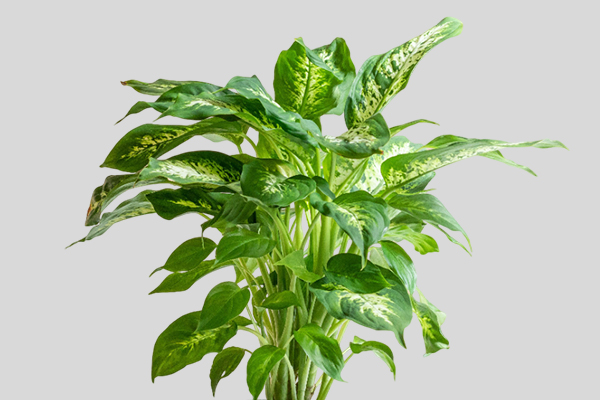
Dieffenbachia
A popular ornamental foliage plant with large bright leaves covered with patterns of green and light spots. Originating from the tropical forests of Central and South America. Dieffenbachia looks spectacular in the interior and, with proper care, can become a true decoration of the home and office. To keep the plant attractive, it is necessary to follow a few simple care rules.
Placement
Dieffenbachia loves bright but diffused light. On southern windows it needs shading to avoid burns. Ideally, place the plant on the east or west side of the apartment. With insufficient light, the leaves become smaller and lose their characteristic pattern. It is important not to place it near radiators or in drafty areas, as it does not tolerate sudden temperature changes.
Watering
Watering should be regular but without overwatering. In summer, about 2–3 times a week, in winter – once every 7–10 days. The top layer of soil should dry slightly before watering again. Use soft, room-temperature water. Dieffenbachia prefers high air humidity, but spraying is not recommended as it leaves stains and can cause rot; instead, a humidifier is advised.
Feeding
During the active growth period – from March to September – the plant should be fed every 2 weeks with complex fertilizers for ornamental foliage plants. Feeding helps maintain rich color and stimulates new leaf growth. In winter, fertilizers are not required as the plant rests.
Repotting
Young Dieffenbachia plants are repotted annually in spring into a slightly larger pot. Mature plants can be repotted every 2–3 years, or simply have the topsoil replaced if needed. The soil should be fertile, loose, and well-drained. A mix of turf soil, peat, and sand with drainage is suitable.
Temperature
Dieffenbachia prefers warmth and stability. The optimal temperature is +20…+26 °C. Sudden changes and cold below +15 °C, as well as watering with cold water, cause rotting of leaves and stems. The plant is not frost-resistant, so it must be protected from cold drafts and airflow.
Pruning
Pruning is necessary to form a beautiful bush. It is usually done in spring. Long stems are shortened to stimulate side shoots. Yellowed or damaged leaves are also removed. Gloves should be worn during pruning as Dieffenbachia sap is toxic and may irritate the skin.
Conclusion
Dieffenbachia is an impressive yet unpretentious indoor plant. It requires bright diffused light, regular but moderate watering, feeding during the active growth season, repotting when needed, stable temperature, and occasional pruning. With proper care, it retains its decorative value for a long time and delights with lush green leaves, adding coziness and freshness to the home.
